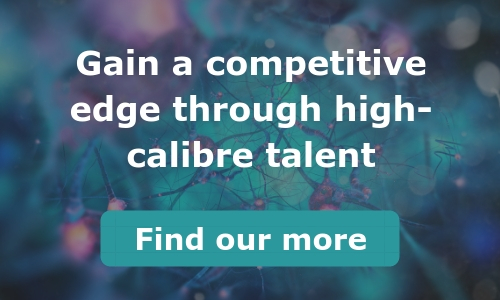It can be tricky to tell the difference between a good candidate and a great one from a CV alone. But it’s a task that Talent Aquisition, HR and hiring managers must fulfil if they are to screen and shortlist the best possible talent to join their life science organisation. When you consider that a life science vacancy could potentially draw hundreds of applications, the risk of the hiring team going ‘CV blind’ is a very real prospect.
As a hiring manager in the life sciences, you want to hone in on A-players as fast as possible. You want someone who possesses the skills, experience, and competencies to excel in the role and grow the bottom line. However, if you are not sure how to go about screening and shortlisting senior hires, you can easily overlook the candidates who can add the greatest value. And that can make the difference between hiring success and failure.
Screening and shortlisting
Screening and shortlisting go hand-in-hand. It’s a two-part process whereby you eliminate candidates who don’t meet the minimum requirements of the job specification (screening) and then, select those candidates who best meet the required and desired criteria for interview (shortlisting).
When screening and shortlisting talent, it’s important to review a candidates CV and LinkedIn together. This is because:
- Reviewed in isolation, a CV or LinkedIn profile may not always give you the complete picture.
- Well-compiled LinkedIn profiles can include more information and career detail than CVs.
- Comparing a CV and LinkedIn profile can reveal inconsistencies and potential red flags.
Screening
Screening is a time-intensive yet vital part of the hiring process. If you’ve advertised the job, you might find up to 80% of applicants aren’t qualified.
The process itself should be conducted in two steps:
- Screen candidates based on minimum requirements, e.g. whether they have a visa to work in the country or if they have a degree.
- Screen candidates based on preferred qualifications, e.g. whether they have experience or a qualification in the desired area.
Screening is usually conducted by Talent Aquisition or HR, with the hiring manager getting involved at shortlisting.
Shortlisting
When preparing a shortlist, you should be reviewing a candidate’s soft skills and technical competency, but also their personality, career motivations, and ambition for the future. While some candidates will have a stellar career record, they may not be a good cultural or DNA fit for your organisation. Reading between the lines can help you avoid hiring the wrong candidate.
Exactly how many candidates make it to interview will depend on your hiring needs:
- For a single role, only the top few candidates (the eighty percentile) should be interviewed.
- For multiple roles of the same levelling, all candidates who meet the minimum requirements should be interviewed.
- For multiple roles at different levelling, only the top few candidates (the eighty percentile) should be interviewed.
Tip: If you are hiring resources are strained, or your application’s aren’t hitting the mark, consider working with an executive search firm specialising in your industry niche.
Signs of an A-player
An organisation is only as strong as it’s people. In an industry as competitive as the life sciences, you need the best talent to gain a competitive edge and grow the bottom line. Nothing less will do.
But how do you tell the difference between a good and great candidate? And how does that manifest itself on a CV and LinkedIn profile?
In his 1961 book “The Achieving Society”, David McClelland, American psychologist and pioneer in the field of workplace motivation, states that we are driven by three basic motivators: the need for achievement, the need for affiliation and the need for power. But depending on our background and personalities, one of these three needs becomes our dominant motivator.
For A-players, the need for achievement is most likely the dominant driver; the need for power a close-run second. Look for the following evidence of A-players on CVs and LinkedIn profiles:
- Accomplishments: A-players motivated by achievement thrive in challenging situations. Look for examples of significant projects, like establishing a Good Clinical Practice (GCP) function.
- Leadership: High-calibre Individuals who crave power work best when they’re in charge, so look for evidence of authority, for example, leading projects, teams or entire divisions.
- Recognition: This can manifest itself in multiple ways. Have they been nominated for an industry award? How about a series of promotions? Look for signs of success.
While the above criteria might be an excellent litmus test for discovering top talent, don’t neglect these other signs of an eighty percenter:
- Thought leadership: Top talent are often subject matter experts. Look for examples of articles, infographics, white papers and videos demonstrating their industry know-how.
- Mentoring employees: A-players know the importance of upskilling their team. Look for evidence of mentoring such as LinkedIn testimonials from employees they mentored.
- Life-long-learning. To be successful in the role, eighty percenters know they must keep their skills relevant. Look for evidence of formal training, conference attendance and courses.
RELATED: Increase quality-of-hire by partnering with a reputable boutique talent consultancy
Conducting a CV and LinkedIn profile review
Now you know the telltale signs on an A-player, it’s time to screen and shortlist candidates for interview.
Start with the applicant’s CV. Unlike a LinkedIn profile, which tends to be written for all audiences, diligent candidates will tailor their CV to fit the job specification or job advert.
CV review
The following are indicative that a candidate is both credible and capable of excelling in a senior-level life science role:
- Accomplishments: A great CV emphasises the candidate’s achievements and provides examples to support them. Do their accomplishments reflect the definition of success in the role?
- Performance metrics: Check for KPIs and results of key projects and initiatives. How did the candidate bring value to their current or past employers? Could they do the same for you?
- Experience: With senior management and executive-level roles, experience is mission critical. Does their verifiable experience match the requirements on the job specification?
- Responsibilities: Compare the applicants current and past responsibilities to those on the job specification. Do they align? If there’s a close match, shortlist the candidate.
- Skills: This includes both hard (technical) and soft (people) skills. Does the candidate possess the mission-critical skills for success in the role?
- Qualifications: Certain qualifications are a prerequisite. Is the applicant degree qualified? Have they bolstered their education with courses like Six Sigma?
- Education: A good senior manager wants to keep their skills relevant. Evidence that the applicant has pursued further education signals both dedication and commitment.
- Time-in-role: Pay close attention to high much time they spent in their past positions. Loyalty is a key quality for senior leaders, as their contributions are essential to company operations.
- Format: Review the content for typos and a hurried communication style. While a two-page CV is ideal, don’t penalise candidates if their CV extends beyond two pages.
LinkedIn profile
In addition to the indicators highlighted when reviewing a CV, look out for :
- Projects: Look for reference to programmes they have launched or high-profile projects they have managed at a reputable Life Science organisation.
- Media/Publications: LinkedIn allows users to add relevant publications, helping them demonstrate their thought leadership in a particular life science dicipline.
- Honours & Awards: Has the applicant received any industry awards or recognition? If they have, they will likely have filled out this section of their LinkedIn profile.
- Skills & Endorsements: Look for the keywords (skills) that demonstrate the applicant’s industry knowledge and how many people have endorsed them for a particular skill.
- Culture: How does the candidate present themselves in the Summary section of their profile. Do they come across as someone who would fit your organisational culture?
- Recommendations: LinkedIn allows professionals to endorse one another for certain skills. Do these recommendations make the person sound like someone who would excel in the role?
When reviewing a candidate’s LinkedIn profile, be sure to fact-check all information to confirm the content tallies with their CV.
Candidate Red Flags
Execute your CV or LinkedIn profile with the due diligence of an executive search consultant. This means spotting warning signs that the individual may not be a good technical, cultural or DNA fit.
Identifying these candidates early and removing them from the hiring process is a win-win situation for all parties. You don’t want to be wasting your valuable time – or your candidates – in interview, yet alone risking the chance of a candidate bluffing their way into a seat. The cost of a bad senior level hire can be between four and fifteen times their annual salary!
Thankfully, your hiring process should reduce the odds of an underqualified candidate making headway, and that starts with the CV and LinkedIn profile review. Red flags manifest themselves in mistakes, errors and indicators that can provide valuable insight into their personality and conduct, as well as helping you spot fraudulent claims early on.
- Employment gaps: Candidates should specify dates of employment for all roles listed. If there appear to be gaps, clarify with the candidate. They could be a job hopper.
- Lack of accomplishments: If a candidate does not list any accomplishments and focuses more on skills or qualifications, they may not be results-oriented.
- Irrelevant information: Bulking up a CV with off-topic or irrelevant information could be an indicator that they lack experience or that they have submitted a generic CV.
- Short tenures: The average employee stays in their position for approximately four years. A CV that shows more frequent job changes could be a sign of burnout or difficult relationship
- Inconsistency: If you notice an inconsistency in the details on their LinkedIn profile and their CV, it’s possible that they are not honest about their capabilities.
- Dishonesty: Always verify promotions, training and performance with references to ensure they are not exaggerating their achievements or competencies.
- Spelling and formatting: These reveal a lack of attention to detail. Candidates who are keen to impress will ensure their CV is spell checked and well formatted.
Do a final social sanity check before shortlisting a candidate. Does everything in their CV match the contents of their LinkedIn profile? Does their online persona suggest a person who is competent, confident, and qualified? According to Recruiterbox, 51% of employers who check and applicants social media profile disqualified a candidate.
Conclusion
Finding the best candidate for the role is mission critical. With a tried and tested process, you’ll be screening and shortlist top-talent in record time.
Not only does an optimised process help ensure you find the best candidates, but it can help you reduce time-to-hire, improve your candidate experience and reduce hiring expenditure.
If your hiring resources are strained, or your applicant’s aren’t hitting the mark, consider working with an executive search firm specialising in your industry niche. Professional headhunters can undertake a CV and LinkedIn profile screen and qualify candidates ahead of shortlisting, saving you time and helping you identify A-players that can move the bottom line.
For more hiring advice tailored to hiring managers in the life science industry…
- Read How To Optimise Your Hiring Process To Attract Top Life Science Talent.
- View our talent solutions to see how we can help you gain a competitive edge through talent.
* Fraser Dove International is a talent consultancy operating exclusively across the life sciences industry. While our roots lie in executive search, we provide more than the traditional recruitment services. Uniquely placed within the market, we have been providing cutting-edge talent solutions and insight to organisations at all stages of their journey – from start-up to established leaders – since 2013.

 Estimated read time: 7 mins
Estimated read time: 7 mins Date posted:04/03/2019
Date posted:04/03/2019





